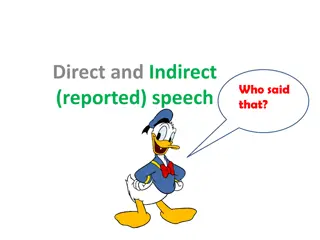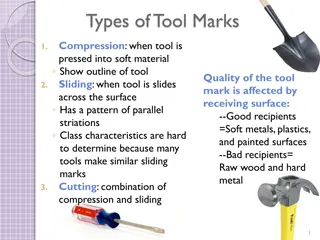Mastering the Art of Using Speech Marks for Direct Speech
Learn how to effectively use speech marks (inverted commas/quotations marks) to punctuate direct speech. Discover the rules for using speech marks, examples of correctly punctuated sentences, and when to use question marks in speech. Enhance your writing skills with proper speech punctuation.
Download Presentation

Please find below an Image/Link to download the presentation.
The content on the website is provided AS IS for your information and personal use only. It may not be sold, licensed, or shared on other websites without obtaining consent from the author. Download presentation by click this link. If you encounter any issues during the download, it is possible that the publisher has removed the file from their server.
E N D
Presentation Transcript
L.I we are learning to use speech marks (inverted commas/quotations marks) to punctuate direct speech.
What are speech marks? Speech marks are punctuation marks that show what somebody has said. They are also called inverted commas, because they are commas that are inverted or reversed to go around the spoken words or dialogue.
To be successful: 1. Put around the words the speaker says. 2. A new speech sentence starts with a capital letter (even if it is the middle of another sentence). 3. Separate the rest of the sentence with the speech using a comma unless - there is already a ? or an ! 4. Use a comma before opening speech marks (if the speech is within a sentence)
Watch me! If you are accessing this video via the website, please go on to this powerpoint slide after you have viewed this video and click on this link https://www.youtube.com/watch?v=OLB1IUNd oSE
This was interesting, said Mrs Pattinson.
The shadow hissed, Go away!
Where are we? asked Jenny.
I like to watch television in the evenings. Mr Samir said, I like to watch television in the evenings. We write what the person says inside the speech marks.
Would you like to play football? asked Colin. Would you like to play football?
Can you punctuate the speech in this sentence correctly. The man shouted get out of the way! The man shouted, Get out of the way!
Lets look at when we use speech and it is a question. The question mark (?) always comes at the end of what is being said and before the final speech mark( ). So:
Can I have my reading book, please? the boy asked. OR: The boy asked, Can I have my reading book, please?
NOTICE: Speech (what is being said) always starts with a CAPITAL LETTER.
Punctuate these question sentences putting in speech marks: 1. The girl asked can I have some money, please 2. Where s my hat the old man requested 3. The woman enquired what was that sound
1. The girl asked, Can I have some money, please? 2. Where s my hat? the old man requested. 3. The woman enquired, What was that sound?
Now, lets look at when we use speech and it is an exclamation. The rule is the same as for question marks: the exclamation mark (!) always comes at the end of what is being said and before the final speech mark ( ). So:
Remember: When we start the sentence with the person who is doing the speaking, we always put a comma (,) before the first speech mark ( ).
Be quiet! screamed the angry teacher. OR: The angry mother screamed, Be quiet!
Punctuate these exclamation sentences putting in speech marks: 1. Get out screamed the angry father 2. The girl shrieked it s a mouse 3. Get down ordered the sergeant
1. Get out! screamed the angry father. 2. The girl shrieked, It s a mouse! 3. Get down! ordered the sergeant.
Now put the speech marks and correct punctuation in the correct places in these sentences. Don t forget to use the success criteria! 1. don t listen to me said Mark. Don t listen to me, said Mark. 2. jack whispered are we safe yet? Jack whispered, Are we safe yet? 3. the manager called bring me that bag! The manager called, Bring me that bag! 4. i need another drink gasped Louis. I need another drink, gasped Louis.
Now can you work out what is wrong with the punctuation in these sentences. Can you rewrite them correctly? Don t forget to use the success criteria! 1. Give me the chocolate said Dan. Give me the chocolate, said Dan. 2. Gary asked, shall I go next. Gary asked, Shall I go next? 3. Sam didn t finish his work, said Max. Sam didn t finish his work, said Max. 4. The girl snarled you ll be sorry! The girl snarled, You ll be sorry!
Something to think about You will notice that throughout this powerpoint, we have been using different words to describe the speech. Don t listen to me, said Mark. said doesn t add any description about how Mark was communicating, feeling, acting
The girl shrieked, Its a mouse! The use of shrieked tell us that the girl is scared of mice it adds to the atmosphere of the story and the character description.
Even better Can you challenge yourself to add even more description when using speech e.g. Get down! ordered the sergeant, as he reached for his radio to call for back up. Adding this additional information can add action to your dialogue.
Your tasks Mild punctuate speech sentences correctly in sentences and find alternatives to said Spicy as above with longer sentences and using context clues to describe the dialogue Hot Identify speech in paragraphs and punctuate this appropriately. Add action to speech to up-level this description
Remember our success criteria? Success Criteria: Did I meet the Success Criteria? Put around what words the speaker says. A new speech sentence starts with a capital letter (even if it is the middle of another sentence). Separate what was said from speaker with a comma unless there is already a ? or an ! Use a comma before opening speech marks (if the speech is within a sentence)























